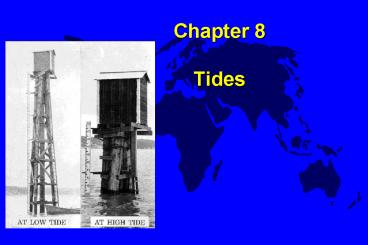Chapter 8 Tides - PowerPoint PPT Presentation
1 / 27
Title:
Chapter 8 Tides
Description:
The diurnal activity of fiddler crabs. The spawning behavior of the grunion fish. Diurnal Activity of Fiddler Crabs (Figure B8-4) Natural. in burrows. Searching ... – PowerPoint PPT presentation
Number of Views:40
Avg rating:3.0/5.0
Title: Chapter 8 Tides
1
Chapter 8Tides
2
Tidal Characteristics
- single waves - stretch across entire ocean
basins. - shallow-water waves
- wavelengths greatly exceed the depth of the
ocean. - complex interactions of moon and sun
3
Origin of the Tides
- Unlike wind-driven surface waves and unlike
tsunamis, tides are caused by two principal
factors - Gravitational attraction
- Centrifugal force
4
Gravitational Attraction
- All masses are drawn to each other.
- The moon because of its closeness to the Earth
exerts a greater gravitational effect on the
Earth than the Sun, despite the fact that the Sun
is much more massive than the Moon.
5
Gravitational Effect of Moon(Figure 8-5a)
6
Animation courtesy of NASA Goddard Space Flight
Center The Moon's gravity tugs at the Earth,
causing ocean water to slosh back and forth in
predictable waves called tides. We can visibly
observe some of that energy dissipate at the
beach, with waves rolling across coastal shallows
and shoals. Most of the energy dissipates due to
friction between the water and the shallow floor
beneath it
7
Centrifugal Force
- Earth and Moon revolving around one another.
- unequal masses of Earth and Moon
- center of rotation lies beneath the Earths
surface. - second tidal bulge
- ocean shifts away from center of rotation
8
Centrifugal Forces Center of Rotation(Figure
8-5b)
9
2 Bulges from Gravitational Attraction
Centrifugal Force(Figure 8-5c)
10
Animation
11
Dynamic Model of the Tides(Figure 8-8a)
12
True Tidal Waves (not tsunamis!)
- The motion of water around the basin is a rotary
wave. - The crest is at one side of the basin.
- The trough is at the other side of the basin.
- Tides have characteristics of both progressive
and standing waves.
13
Standing Waves
- Sea, swell, and surf are progressive waves.
- Standing waves (seiches)
- Oscillate back and forth about a node, i.e., a
fixed point.
14
Node Fixed Point Antinode maximum
displacement(Figure 7-11)
15
Dynamic Model of theTides(Figure 8-8a)
16
Dynamic Model of theTides(Figure 8-8b)
Earth rotates from W to E Tidal bulge to W
Pressure Gradient Coriolis
cut-away
Pressure Gradient Coriolis
Pressure Gradient Coriolis
cut-away
17
Dynamic Model
- equilibrium model of the tides is good, BUT...
- not totally detailed and accurate
- oceans are separated by continents
- oceans not infinitely deep
18
Animation courtesy of NASA Goddard Space Flight
Center Using 6 years of data from TOPEX/Poseidon
satellite altimeter, they derived a 16-day set of
predictive data, showing a synthetic view of how
the tides move around the world's oceans.
19
Key Features of Tides
- High tide Wave crest
- Low tide Wave trough
- Tidal range Wave height
- Tidal periods depending on location
- 12 hours, 25 minutes
- 24 hours, 30 minutes
20
Wave Parameters(Figure 7-1a)
21
Tidal Periods
- why not exactly 24 hours or 12 hours?
- Moon moves forward in its orbit each day.
- Takes 50 additional minutes for a spot on the
Earths surface to regain its position relative
to the Moon.
22
Classification by Daily Record
- Diurnal have one high tide and one low tide
daily (high lat). - Semidiurnal have two high tides and two low
tides daily (low lat). - Mixed there are two high tides and two low tides
daily, but of unequal shape (mid lat).
23
Classificaton by Monthly Record
- Spring tide phase when tidal range is maximal.
- Neap tide phase when tidal range is minimal.
- There are 2 spring and 2 neap tides each month
24
Spring Neap Tides
- Spring tides occur when the Earth, Sun, and Moon
are aligned. - New Moon and Full Moon phases
- Constructive interference
- Neap tides occur when the Sun and Moon are
aligned at right angles to one another. - Quarter Moon phases
- Destructive interference
25
Sun/Moon/Earth - Spring Neap(Figure 8-7a)
26
Marine Biorhythms
- Cyclical behaviors associated with tidal rhythms.
- The diurnal activity of fiddler crabs.
- The spawning behavior of the grunion fish.
27
Diurnal Activity of Fiddler Crabs(Figure B8-4)
Natural
Searching for food
in burrows

